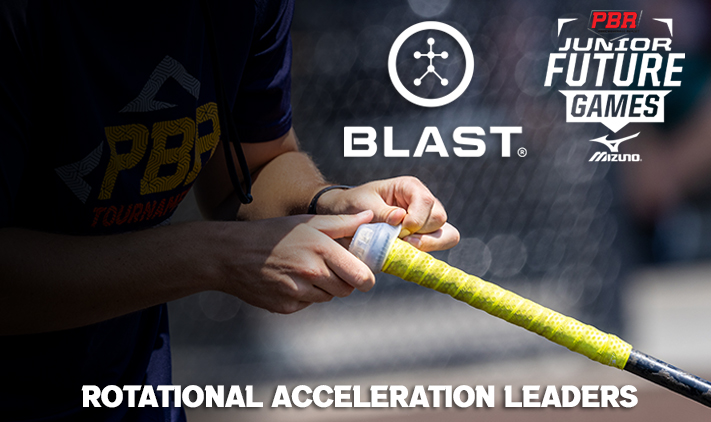2023 PBR Junior Future Games: Rotational Acceleration Leaders
August 14, 2023

When using Blast Motion to evaluate current and future MLB prospects, most people assume that Bat Speed is the metric we utilize the most. However, it is actually Rotational Acceleration that has been the most useful in forecasting a hitter’s ability to perform at the Major League level.
Let’s explore why.
At Blast, we consider Bat Speed a prerequisite for professional baseball. Most of the time, when a player is at elite levels of amateur or professional level, they tend to have the Bat Speed needed. Bat Speed is also something we’ve seen be improved over and over again, especially with resources such as Driveline’s Bat Speed Program, where they utilize the Axe Bat Speed Trainers and Blast Motion Swing Analyzers – a program that MLB players like Mookie Betts and J.D. Martinez use.
Over the many years of analyzing professional baseball Blast Data, we’ve uncovered the significant role that Rotational Acceleration plays in a player’s ability to contribute offensively at the Major League level. It’s not simply about Bat Speed when it comes to facing Big League pitching, though it’s undoubtedly a crucial factor. What we’ve found is more nuanced: a player might dominate at levels like high school, college, and even the lower tiers of minor league baseball with Bat Speed alone. However, to truly excel at the Major League level, a player needs to have the ability to accelerate into that bat speed quickly – they need Rotational Acceleration.
We’ve seen that if that player can’t accelerate quickly into their Bat Speed, they tend to struggle against pitching at High-A and above. Once you get to that High-A, Double-A, Triple-A, and even the MLB level – you are now facing the pitchers who not just have the best “stuff,” but also the guys who have developed the best arsenals, including pitches that all come out of the same tunnel. And when you have three to four different pitches coming out of the same tunnel, you have to make a later decision to swing, and to do that; you have to be able to accelerate the bat as quickly as possible. Therefore, the higher the Rotational Acceleration values, the higher the percentage for success against elite arsenals
Below is a visual displaying when a hitter needs to make the decision to swing in order to be on time, based on their Rotational Acceleration values.
- Cluster 1 = 1-10 Gs
- Cluster 2 = 11-20 Gs
- Cluster 3 = 20-plus Gs
Players in Cluster 3 (performers with over 20 Gs of Rotational Acceleration) have the highest percentage of success against MLB-level pitching. However, the MLB average for Rotational Acceleration is 17 Gs – so this is an excellent goal to strive for.
It’s also important to understand where Rotational Acceleration is measured. At Blast, we look at the swing in four phases – Stance, Load, Transition-GO, Swing, and Impact.
Rotational Acceleration is measured starting from the Transition-Go Event until the back elbow is slotted. Measuring Rotational Acceleration early in the swing allows for precise comparisons, both from one swing to the next and from one player or another. This method of evaluation minimizes the impact of variations that the location and type of pitch might cause. Examples of these differences would be adjusting to a curveball down, turning on an inside fastball, or hitting an outside pitch deeper in the zone the other way.
Regarding the MLB Draft, Rotational Acceleration is often the key measurement that teams rely on. Think of it this way: if you’re running a Major League baseball organization, does drafting a pitcher that throws 96 mph guarantee the player will be a successful Major Leaguer? Not necessarily. But you still want an organization full of pitchers that can throw 96 mph – the same idea applies to hitters in a Major League organization. Having a player with 20-plus Gs of Rotational Acceleration doesn’t guarantee a successful big league hitter, but I would still want an organization full of hitters that can accelerate their bat 20 Gs or higher.
What makes Rotational Acceleration more challenging to enhance than other metrics is that it isn’t tied to just one aspect of a player’s abilities. It’s not solely about mechanics, fundamentals, flexibility, or strength. Instead, it’s a complex combination of all these factors. Improving Rotational Acceleration requires a multifaceted approach, addressing each of these elements in harmony.
However, there are some great workouts a player can do that can help teach their body to self-correct itself during the swing to improve their Rotational Acceleration. You can find these through Blast Motion's performance partner, Rockland Peak Performance (RPP).
Key Takeaway: As a hitter, the higher the level of pitching, the more Rotational Acceleration can help you. The higher the Rotational Acceleration values, the later the hitter can decide to swing – a quality that increases the percentage for success at High-A and above.
Below is a list of the top-15 players with the highest Average Rotational Acceleration:
-
Grayson Davis, 35.5g
-
Jake Ivester, 31.2g
-
AJ Hogart, 30.2g
-
David Tiernosky, 29.1g
-
Max Molloy, 27.4g
-
Micah Leyva, 26.4g
-
Kilby Hartley, 26.4g
-
Lincoln Demmons, 25.8g
-
Joaquin Jr. San Nicolas, 24.8g
-
Cooper DeVries, 24.6g
-
Rogan Tyler, 24.6g
-
John Ross Milburn, 24.4g
-
Grant Stafford, 23.3g
-
Isaias Torres, 23.3g
-
Winston Patterson, 23.1g
RELATED CONTENT
